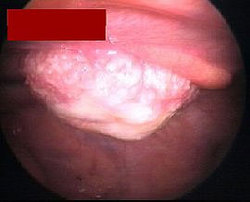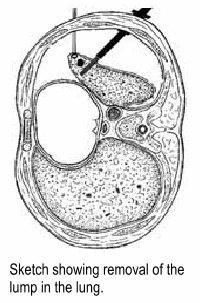Surgery for Lung Cancer and Undiagnosed Lung Masses
 This is a lung tumor under the rib cage.
This is a lung tumor under the rib cage.
If the lung tumor is near the large windpipes, the surgeon will use a bronchoscope to look the main airways to make sure that the tumor can be removed. This takes about 10 minutes and is done while the patient is under general anesthesia. Next, if cancer is likely and mediastinoscopy has not been performed, the patient has a small incision made at the base of the neck and a lighted tube is inserted next to the windpipe. Through this tube, lymph nodes can be sampled to make sure that tumor has not spread to them.
Removing the Lung Nodule
Then the patient will undergo an operation to remove the lump. If the tumor is benign or if the patients breathing capacity is too poor to undergo a standard lung cancer operation, only the lump is removed with a margin of healthy tissue around it.
Removing the Lung Cancer
Removing only the lung cancer with a rim of normal tissue around it is insufficient therapy for patients who can tolerate a standard lung cancer operation. This is because all the blood vessels and lymph glands that drain the tumor area need to be removed as well in order to "catch" tumor cells that are starting to spread.
This operation is called a lobectomy when a major portion, or lobe, of a lung is removed and is called a pneumonectomy when a whole lung is removed. The right lung is slightly larger than the left lung and has 3 lobes as compared with the left lung's 2 lobes.
The lung cancer operation is generally performed through a side chest incision (thoracotomy) that spreads between ribs five and six. This operation causes considerable post-operative pain and limits return to work for 1 to 3 months depending on the activity levels required of the job. It has the advantage of providing a wide working space for the surgeon to work, which is important for certain tumors.
For some patients, this operation can be performed with minimally invasive techniques. Read about minimally invasive surgery.
Palliating Lung Cancer
Operations are also useful in reducing the complications of lung cancer that has become more advanced. Minimally invasive surgery is useful in diagnosing spread of tumor in the space around the lung and applying medicine to prevent fluid from accumulating and making it harder for the patient to breathe.
Removing the Lung Nodule
Then the patient will undergo an operation to remove the lump. If the tumor is benign or if the patients breathing capacity is too poor to undergo a standard lung cancer operation, only the lump is removed with a margin of healthy tissue around it.
Removing the Lung Cancer
Removing only the lung cancer with a rim of normal tissue around it is insufficient therapy for patients who can tolerate a standard lung cancer operation. This is because all the blood vessels and lymph glands that drain the tumor area need to be removed as well in order to "catch" tumor cells that are starting to spread.
This operation is called a lobectomy when a major portion, or lobe, of a lung is removed and is called a pneumonectomy when a whole lung is removed. The right lung is slightly larger than the left lung and has 3 lobes as compared with the left lung's 2 lobes.
The lung cancer operation is generally performed through a side chest incision (thoracotomy) that spreads between ribs five and six. This operation causes considerable post-operative pain and limits return to work for 1 to 3 months depending on the activity levels required of the job. It has the advantage of providing a wide working space for the surgeon to work, which is important for certain tumors.
For some patients, this operation can be performed with minimally invasive techniques. Read about minimally invasive surgery.
Palliating Lung Cancer
Operations are also useful in reducing the complications of lung cancer that has become more advanced. Minimally invasive surgery is useful in diagnosing spread of tumor in the space around the lung and applying medicine to prevent fluid from accumulating and making it harder for the patient to breathe.
